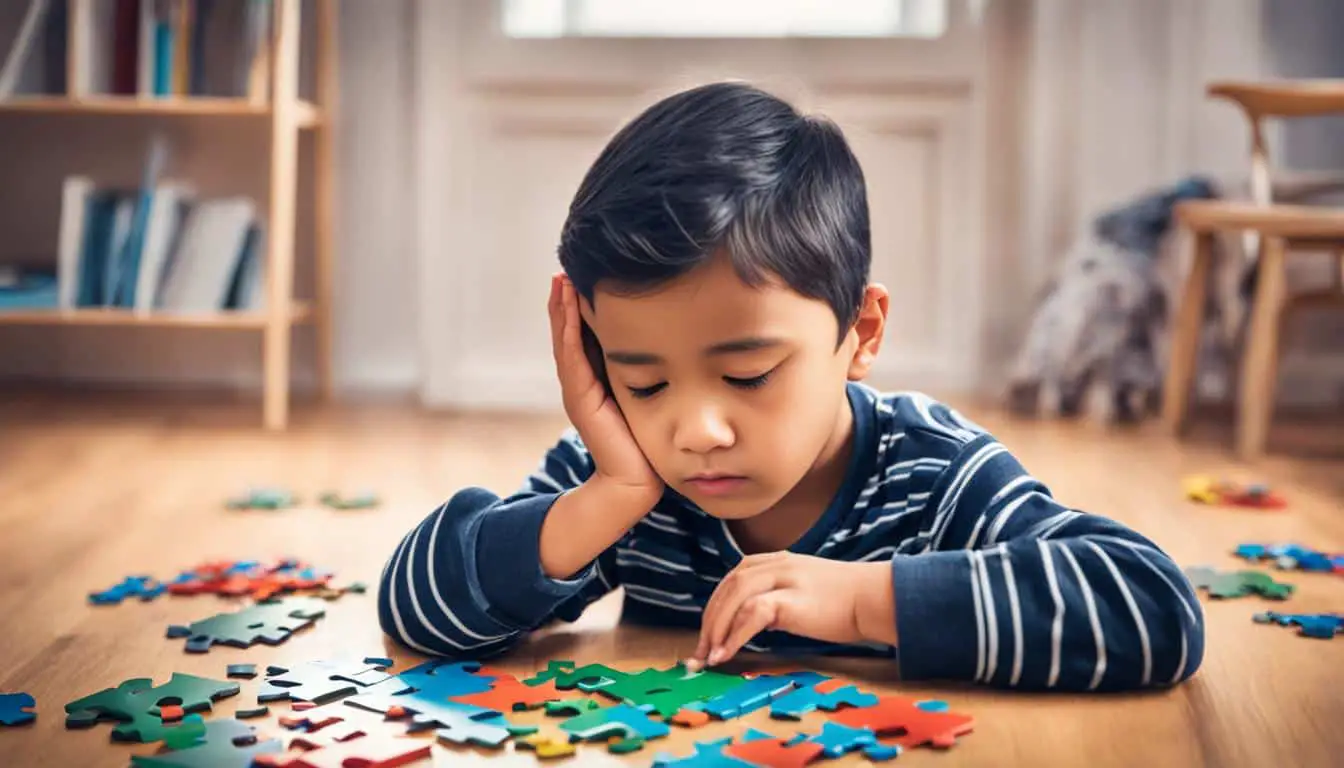Supporting Children with Childhood Learning Disabilities: The Essential Role of Families
As a journalist specializing in education, I have witnessed the impact of childhood learning disabilities on students, families, and educators. These disabilities affect an estimated 7-8% of school-aged children, making them one of the most prevalent childhood disorders.
Understanding childhood learning disabilities and providing the necessary support is critical to mitigating their impact on academic achievement, social relationships, and emotional well-being. Through research, interviews with experts, and real-world examples, this article aims to offer insights into these disabilities and provide strategies for supporting children with learning disabilities.
Key Takeaways
- Childhood learning disabilities are prevalent, affecting 7-8% of school-aged children.
- Understanding these disabilities and providing support is crucial to mitigating their impact.
- This article offers insights and strategies for supporting children with learning disabilities.
- Learning disabilities can have significant academic, social, and emotional consequences.
- Creating inclusive learning environments is essential to fostering success for children with learning disabilities.
Identifying Common Childhood Learning Disabilities
Identifying learning disabilities in children is crucial to ensure they receive the support they need. Here, we will discuss some of the most common learning disabilities that affect children:
| Learning Disability | Characteristics | Challenges | Identification |
|---|---|---|---|
| Dyslexia | Affected reading, writing, and language skills | Difficulty decoding words and interpreting text | Evaluation by a specialist with reading and writing assessments |
| Dyscalculia | Affected math skills | Difficulty understanding and remembering math concepts | Evaluation by a specialist with math assessments |
| Dysgraphia | Affected writing skills | Difficulty with fine motor skills and spelling | Evaluation by a specialist with writing and spelling assessments |
| Attention Deficit Hyperactivity Disorder (ADHD) | Difficulty with attention and hyperactivity | Difficulty with focus and impulsive behavior | Evaluation by a specialist with behavioral assessments |
It’s essential to identify these disabilities early on in childhood to ensure that children receive the support they need. Evaluation by a specialist and assessments tailored to the specific disability are crucial in identifying the disability.
The Role of Families in Supporting Children with Learning Disabilities
Families play a pivotal role in the support and development of children with learning disabilities. Their involvement can significantly influence a child’s self-esteem, academic success, and overall well-being. This section explores key strategies that families can employ to foster a supportive environment for children with learning disabilities.
1. Open Communication:
Maintaining open lines of communication is essential for understanding a child’s needs. Families should encourage their children to express their feelings about school, friendships, and any challenges they face. Regular discussions about what is working and what isn’t can help identify areas where additional support may be needed.
2. Educate Yourself:
Parents and caregivers should educate themselves about the specific learning disability their child faces. Understanding the nature of the disability, its challenges, and effective strategies for support can empower families to advocate for their child’s needs effectively. This knowledge can also help dispel any misconceptions about learning disabilities.
3. Collaborate with Educators:
Building a strong partnership with teachers and school staff is vital. Families should actively participate in meetings regarding their child’s Individualized Education Plan (IEP) and stay informed about their progress. Collaboration ensures that strategies used at home align with those employed in the classroom, providing a consistent support system for the child.
4. Foster Independence:
While providing support is important, encouraging independence is equally vital. Families should promote self-advocacy by teaching their children to express their needs and seek help when necessary. This empowerment can build confidence and help children develop skills to navigate challenges independently.
5. Celebrate Small Achievements:
Recognizing and celebrating small milestones can significantly boost a child’s self-esteem. Families should acknowledge efforts and improvements, no matter how minor they may seem. This encouragement fosters a positive mindset and motivates children to continue working towards their goals.
6. Create a Structured Environment:
Establishing a structured and predictable environment at home can help children with learning disabilities feel secure and focused. Consistent routines, clear expectations, and organized spaces for homework and study can facilitate a conducive learning atmosphere.
7. Encourage Extracurricular Activities:
Participating in extracurricular activities can provide children with opportunities to explore their interests and build social skills. Families should encourage their children to engage in activities that align with their strengths and passions, promoting confidence and a sense of belonging.
By actively engaging in these strategies, families can provide essential support for children with learning disabilities, enhancing their development and quality of life. A nurturing and informed family environment can make a significant difference in helping children overcome challenges and thrive academically and socially.
Understanding the Impact of Learning Disabilities on Kids
Children with learning disabilities are faced with a variety of challenges that can impact almost every aspect of their lives. Emotional, social, and academic consequences are some of the most profound impacts that children with learning disabilities may experience.
Emotional Consequences: Children with learning disabilities can experience significant emotional consequences, such as low self-esteem and a negative self-image. As they struggle in school, it can be easy for them to become discouraged, feel like failures, and lose motivation.
Social Consequences: Learning disabilities can also have significant social consequences for children. Difficulties with communication, comprehension, and reading can make it hard for them to make friends and keep up with their peers. Social isolation and loneliness can become a real issue, which can lead to further emotional challenges and frustrate academic progress.
Academic Consequences: As the name suggests, learning disabilities make it difficult for children to learn and grasp new concepts. They may experience problems with reading, writing, spelling, and math, and may need specialized instruction to keep pace with their peers. If left unaddressed, their academic struggles can lead to delayed progress or even failure.
It’s important to understand the significant impact that learning disabilities can have on children, but also to remember that there are strategies and interventions that can help. With appropriate support and understanding, children with learning disabilities can overcome these challenges and reach their full potential.
Strategies for Supporting Children with Learning Disabilities
As a journalist, I have researched various strategies that can be used to support children with learning disabilities. It is crucial to remember that every child is unique and may require different support strategies. Therefore, it is essential to have an individualized plan for each child. Some of the support strategies that can be useful for children with learning disabilities are:
| Support Strategies | Description |
|---|---|
| Individualized Education Plans (IEPs) | These plans are created to meet the specific needs of each student with learning disabilities. They outline goals, special accommodations, and support services required for academic success. |
| Accommodations | These are changes made in the classroom, such as extended time on assignments or reduced distractions, to help the student with a learning disability learn better. |
| Specialized Instructional Techniques | Teachers can use specialized techniques such as multi-sensory instruction or visual aids to help children with learning disabilities learn more effectively. |
It is also crucial to involve parents, caregivers, and other professionals in the support system. Collaborating with them can help provide comprehensive support to the child. Regular communication with parents and caregivers can ensure that the child’s support needs are being met both at home and at school.
Another essential strategy is to focus on the child’s strengths rather than only their weaknesses. This can help to build their confidence and self-esteem.
Implementing these strategies can help to create a supportive environment for children with learning disabilities, promoting their success both in and out of the classroom.

Promoting Inclusive Learning Environments
Creating inclusive learning environments is vital in ensuring that children with learning disabilities get the necessary support and assistance to succeed academically and socially. Teachers, parents, and schools have a crucial role in promoting inclusivity in the classroom and beyond. The following are some effective ways to ensure inclusivity:
- Provide a variety of teaching methods and materials that cater to diverse learning abilities.
- Encourage peer-to-peer support and collaboration among students with and without disabilities.
- Equip classrooms with assistive technology like text-to-speech software and speech recognition tools.
- Offer specialized support services like one-on-one tutoring and counseling.
- Organize extracurricular activities that cater to diverse interests and abilities.
Quotes from Experts
“Creating inclusive learning environments requires a commitment to recognizing and addressing barriers to learning, participation, and achievement for all students.” – Karen Niemi, Associate Professor, University of Utah
“Education is not one-size-fits-all. Every student has differences in reading, writing, and understanding that need tailored approaches.” – Dr. Rich Weinfeld, Educational Consultant, Weinfeld Education Group

Overall, promoting inclusive learning environments is about ensuring that all students are valued and respected for their unique abilities and perspectives. By creating an inclusive environment, we can foster a sense of belonging and empower students with learning disabilities to achieve their full potential.
Conclusion
In conclusion, understanding childhood learning disabilities is crucial for parents, teachers, and caregivers. By identifying common learning disabilities and understanding their impact on children, we can provide the necessary support and strategies to help children thrive.
It’s important to remember that every child is unique and that there is no one-size-fits-all approach when it comes to supporting children with learning disabilities. By promoting inclusive learning environments and using individualized education plans, accommodations, and specialized instructional techniques, we can help children with learning disabilities reach their full potential.
As someone who works closely with children with learning disabilities, I encourage you to approach each child with empathy and a willingness to learn. By working together, we can create a supportive and inclusive environment that empowers children with learning disabilities to succeed.
FAQ
What are childhood learning disabilities?
Childhood learning disabilities are neurodevelopmental disorders that affect a child’s ability to acquire and use academic and functional skills. These disabilities are often characterized by difficulties in reading, writing, math, or problem-solving, and they can impact a child’s overall academic performance and social interaction.
How common are childhood learning disabilities?
Childhood learning disabilities are relatively common. According to the National Center for Learning Disabilities, around 15% of children in the United States have a learning disability. It is important to note that learning disabilities can vary in severity and can affect children of all backgrounds and intellectual abilities.
How can I identify if my child has a learning disability?
Identifying learning disabilities in children can be challenging, as they may exhibit signs and symptoms that overlap with typical developmental milestones. However, some common indicators include persistent difficulties in reading, writing, math, or communication, struggling to follow instructions, and showing signs of frustration or avoidance when engaged in academic tasks. If you suspect your child may have a learning disability, it is advisable to seek a comprehensive evaluation conducted by a qualified professional.
What impact do learning disabilities have on children?
Learning disabilities can have a significant impact on children’s lives. They may experience emotional challenges, such as low self-esteem or anxiety, as they struggle to keep up with their peers academically. Socially, they may face difficulties in making friends or participating in group activities. Learning disabilities can also hinder their academic progress and future career prospects if not properly addressed and supported.
How can I support a child with a learning disability?
Supporting a child with a learning disability requires a collaborative approach involving parents, teachers, and other professionals. It is essential to create an individualized education plan (IEP) tailored to the child’s specific needs, which may include accommodations like extra time on tests or visual aids. Additionally, providing a supportive and nurturing environment, offering specialized instruction, and promoting self-advocacy skills can greatly assist children with learning disabilities.
How can we promote inclusive learning environments for children with learning disabilities?
Promoting inclusive learning environments involves fostering a sense of belonging and acceptance for children with learning disabilities. Teachers can implement differentiated instruction strategies that cater to diverse learning needs, encourage peer support and collaboration, and provide assistive technologies when necessary. Schools and parents can also work together to promote awareness, train educators, and advocate for inclusive policies and practices.






